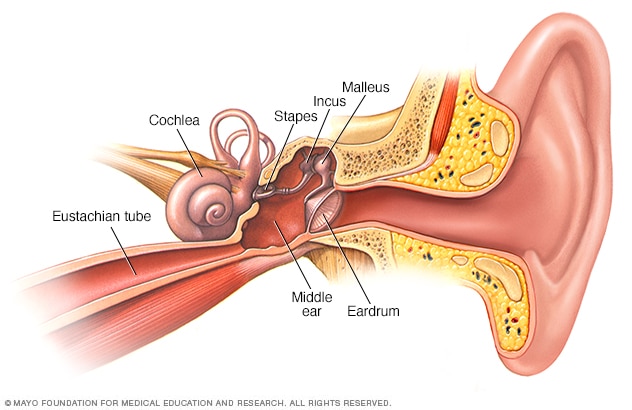Overview
A ruptured eardrum, also called tympanic membrane perforation, is a hole or tear in the thin tissue, also called the eardrum, between the ear canal and the middle ear.
A ruptured eardrum can cause hearing loss. It also can make middle ear infections more likely.
A ruptured eardrum most often heals in a few weeks without treatment. But it might need a patch or surgical repair to heal.

Ruptured eardrum
A ruptured, also called perforated, eardrum keeps sound waves to the middle ear from moving as they should. The tear also can leave the middle ear open to things that cause infections, such as water.
Symptoms
Symptoms of a ruptured eardrum may include:
- Ear pain that may go away fast.
- Mucus, pus-filled liquids or bloody liquids coming out of the ear.
- Hearing loss.
- Ringing in the ear, also called tinnitus.
- Feeling of spinning, also called vertigo.
- Nausea or vomiting that can come from vertigo.
When to see a doctor
Make a medical appointment if you have symptoms of a ruptured eardrum.
From Mayo Clinic to your inbox
Causes
Causes of a ruptured, also called perforated, eardrum may include:
- Middle ear infection, also called otitis media. A middle ear infection often occurs because of a buildup of fluids in the middle ear. Pressure from these fluids can cause the eardrum to rupture.
-
Barotrauma. Barotrauma is stress on the eardrum when the air pressure in the middle ear and the air pressure outside the ear are out of balance. If the pressure is bad enough, the eardrum can tear. Barotrauma is most often caused by air pressure changes during air travel.
Other things that can cause sudden changes in pressure and possibly a ruptured eardrum include scuba diving and something hitting the ear hard, such as an automobile air bag.
- Loud sounds or blasts, also called acoustic trauma. Loud sounds, such as from an explosion or gunshot, rarely can cause a tear in the eardrum.
- Putting things in the ear. Small objects, such as a cotton swab or hairpin, can poke through or tear the eardrum.
- Severe head trauma. Severe injury, such as a skull base fracture, may damage the middle and inner ears, including the eardrums.

Middle ear
The middle ear includes three small bones — the hammer (malleus), anvil (incus) and stirrup (stapes). The middle ear is separated from the external ear by the eardrum and connected to the back of the nose and throat by a narrow passageway called the eustachian tube. The cochlea, a snail-shaped structure, is part of the inner ear.
Complications
The eardrum, also called tympanic membrane, has two main roles:
- Hearing. When sound waves strike it, the eardrum moves. This is the first step by which structures of the middle and inner ears translate sound waves into nerve impulses.
- Protection. The eardrum also acts as a barrier, protecting the middle ear from water, bacteria and other things that don't belong there.
If the eardrum ruptures, problems can happen, especially if it doesn't heal after 3 to 6 months. Complications aren't common. They include:
- Hearing loss. Usually, hearing loss is short-term, lasting only until the eardrum heals. Where the tear is and how big it is play a role in how much hearing is lost.
- Middle ear infection, also called otitis media. A ruptured eardrum can let bacteria into the ear. A small number of people might get repeated or ongoing, called chronic, infections if the hole doesn't heal. This small group might have ongoing fluid leaks from the ear and hearing loss.
-
Middle ear cyst, called cholesteatoma. Although rare, an eardrum rupture that doesn't heal can form this cyst in the middle ear. This cyst is made up of skin cells and other debris.
Ear canal debris often travels to the outer ear with the help of earwax. Earwax protects the ear. If the eardrum is torn, the skin debris can pass into the middle ear and form a cyst.
A cyst in the middle ear lets bacteria grow. And it has proteins that can damage the bones of the middle ear.
Prevention
Follow these tips to avoid a ruptured eardrum:
- Get treatment for middle ear infections. Be aware of the symptoms of middle ear infection. They include earache, fever, stuffy nose and not hearing as well. Children with middle ear infections often are fussy and may refuse to eat. Seek medical care right away to prevent damage to the eardrum.
-
Protect your ears while on airplanes. If possible, don't fly with a cold or an allergy that causes nose or ears to be stuffed up. During takeoffs and landings, keep ears clear with pressure-equalizing earplugs, yawning or chewing gum.
Or use the Valsalva maneuver — gently pushing air into the nose, as if blowing your nose, while pinching the nostrils and keeping the mouth closed. Don't sleep while the plane is taking off or landing.
- Keep things out of the ears. Don't use a cotton swab, paper clip or hairpin to dig out earwax. These can tear the eardrum. Teach children about the damage they can do by putting things in their ears.
- Guard against loud noise. Stay away from loud noises. If you have to be around loud noises, such as at work, wear earplugs or earmuffs.